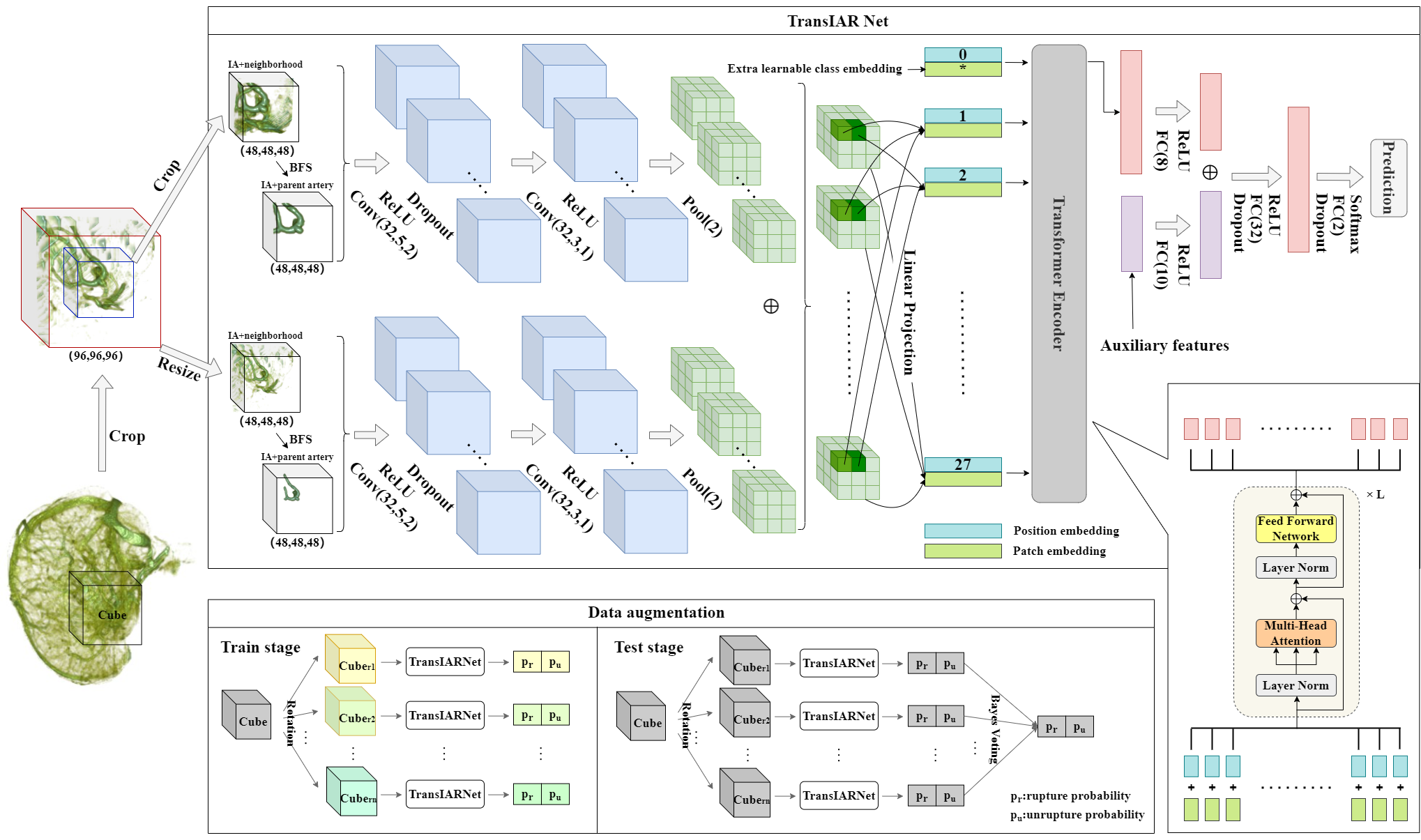This repository contains the source code, trained model and part of the test set for our work: A deep learning method for an end-to-end prediction of rupture status of intracranial aneurysm.
Intracranial aneurysms (IA) seriously threaten human health, and ruptured IA may even cause death of patients. Early assessment on the risk of IA rupture is important for timely and appropriate treatment for patients. To address this issue, we propose an end-to-end deep learning model (TransIAR net) for accurate IA rupture status prediction, without laborious human efforts on hand-crafted morphological features. It takes 3D computed tomography angiography (CTA) data as input and automatically extracts features of IA geometry and neighborhood information. Quantitative experiments demonstrate the superior performance of the proposed method. To the best of our knowledge, TransIAR net is the first end-to-end method for IA rupture prediction directly on the 3D CTA data. It is a promising artificial intelligence tool to assist the doctors for efficient, accurate clinical diagnosis and timely treatment of IA patients.
python==3.8
einops==0.5.0
numpy==1.22.3
scikit_learn==1.1.3
torch==1.12.1
Install dependencies:
pip install -r requirements.txt
dataset_cta_balanced_train.pkl and dataset_cta_balanced_test.pkl are 3D CTA cubes of Balanced Dataset, each case augmented 32 times.
dataset_af_balanced_train.pkl and dataset_af_balanced_test.pkl are the corresponding auxiliary features of Balanced Dataset.
You can obtain the required training and test data according to the following code examples:
X_train = torch.tensor(dataset_train['vox_train'])[:,0:1,:,:,:] ## 96-sized patches (without BFS)
X_train = torch.tensor(dataset_train['vox_train'])[:,1:2,:,:,:] ## 96-sized patches (with BFS)
X_train = torch.tensor(dataset_train['vox_train'])[:,2:3,:,:,:] ## 48-sized patches (without BFS)
X_train = torch.tensor(dataset_train['vox_train'])[:,3:4,:,:,:] ## 48-sized patches (with BFS)
X_test = torch.tensor(dataset_test['vox_test'])[:,0:1,:,:,:] ## X_test is the same
We only provide the balanced test set (82 cases) dataset_cta_balanced_test.pkl and dataset_af_balanced_test.pkl due to hospital regulation restrictions and patient privacy concerns, which can be downloaded from https://zenodo.org/record/7536330#.Y8Jawi-KFEQ.
To test our model, download dataset_cta_balanced_test.pkl and dataset_af_balanced_test.pkl to /dataset folder and then run python test_wo_af.py and python test_w_af.py, which are expected to get the following output respectively,
Accuracy: 89.02
Precision: 88.1
Recall: 90.24
F1 score: 89.16
AUC: 92.15
AUPR: 93.16
Accuracy: 91.46
Precision: 94.74
Recall: 87.8
F1 score: 91.14
AUC: 92.09
AUPR: 89.58
models.py contains two models we proposed, one is TransIAR (TransIAR-Net without auxiliary features), the other is TransIAR_AF (TransIAR-Net with auxiliary features), i.e. the final model.
transformer.py contains the transformer module.
utils.py contains some functions for calculating metrics.
To train TransIAR, run
python train_wo_af.py
To train TransIAR_AF , run
python train_w_af.py
To test TransIAR on Balanced Dataset, run
python test_wo_af.py
To test TransIAR_AF on Balanced Dataset, run
python test_w_af.py
Note that only python test_wo_af.py and python test_w_af.py can be executed successfully due to data inaccessibility, while you can train and test our method on your own datasets.
model_wo_af.pth is the trained model of TransIAR, whose accuracy on Balanced Dataset is 89.02.
model_w_af.pth is the trained model of TransIAR_AF, whose accuracy on Balanced Dataset is 91.46.
We consider relevant SOTA 2D or 3D models in the literature, including the work of Kim et al., M3T and DAResUNET, and reproduce them for comparisons. It should be noted that the existing 3D models are not for the IA rupture status prediction problem, and thus we modify them appropriately to adapt to the problem setting in this paper. We use 48+96 (without BFS) as the input for the compared 3D methods (M3T and DAResUNET) for a fair comparison.
In addition to the Balanced and Imbalanced datasets, we also collected CTA images of 43 patients from other four hospitals and merge them as an external test set.
We evaluate our model and other competing methods on the external test set without auxiliary features. The results are as follows:
| Models | Accuracy | Precision | Recall | AUC | AUPR | F1 score |
|---|---|---|---|---|---|---|
| 65.12 | 76.92 | 68.97 | 72.66 | 83.99 | 72.73 | |
| 58.14 | 82.35 | 48.28 | 80.05 | 89.79 | 60.87 | |
| 65.12 | 100.0 | 48.28 | 91.63 | 96.01 | 65.12 | |
| 76.74 | 95.24 | 68.97 | 94.09 | 97.12 | 80.00 | |
| 83.72 | 95.83 | 79.31 | 94.58 | 97.54 | 86.79 | |
| 88.37 | 100.0 | 82.76 | 97.29 | 98.71 | 90.57 | |
| 90.70 | 96.30 | 89.66 | 95.32 | 97.80 | 92.86 | |
| 93.02 | 100.0 | 89.66 | 98.03 | 99.17 | 94.55 |
The results on the external test set shows that TransIAR has good generalization performance and is potentially a useful model for clinical utility to help radiologists in the assessment of IA rupture risk.
